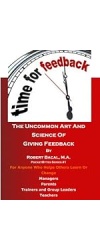Yes, there is such a thing as an effective performance review. Here’s how to get there.
Unclear vs. Clear Definition
There are currently a lot of definitions and different terms used to describe meetings where performance is discussed. For example, there are performance reviews, performance appraisals, employee reviews, and performance management, just to name a few.
Some of these terms differ only slightly in meaning and some differ significantly. Believe it or not, you’ll find that where performance reviews don’t work well, it’s often the case that people don’t share a clear common definition and understanding of performance reviews. Managers and HR staff assume that people understand it the same way, but there’s no guarantee that’s the case. We need a definition that explains both the process and the main purpose of the performance review
I recommend using performance review rather than performance appraisal or performance evaluation because it captures the idea of reviewing performance together.
Here’s one way of defining it.
The performance review is usually a face to face meeting between manager and employee to discuss the employee’s performance for the purpose of removing barriers to performance. It does not stand on its own, but is intimately tied to other parts of a larger performance management process.
We need to define performance management also, but we’ll do that later on.
A definition is useless, of course, unless everyone involved understands it. Whether you use this definition or another, it’s important that executives, HR staff, managers, and employee all understand it. That means communication among all of the parties.
Narrow vs. Broad Views of Performance
Ineffective performance reviews tend to focus almost entirely on what the employee has done and what the employee needs to do to improve his or her performance. That’s in line with some of our cultural values that suggest that we are the masters of our fate and we control our behavior and the results of that behavior. The problem is not that these cultural values are correct or incorrect, but that they are incomplete. The behaviors of an employee, the results, and the contributions are affected by various factors, many of which are not under the control of the employee. If our goal is to improve performance, we must look at a broader spread of causes and not only at the employee. Even the most talented employee is going to have difficulty performing well if he or she lacks the tools, is impeded by poor business and production planning, is not given sufficient resources, or is adversely affected by the work environment. So, it’s important-particularly when trying to determine “what went wrong” and “how to fix it”-to look broadly for causes and solutions.
Skilled Managers vs. Unskilled
Just as employees differ in terms of job skills, managers vary in terms of the job skills required to manage employees or, more specifically, to plan and conduct performance reviews.
Almost anyone can sit down with an employee, tell where he or she screwed up, and threaten with punishment. We’re fairly good at that. To lead a performance review that builds positive relationships and improves performance requires more advanced interpersonal, ommunication, and problem-solving skills. In short, it takes little skill to do something badly. It takes fairly sophisticated skills to do something well. The skills of the manager have an effect on the success or failure of the performance review process.
Generic vs. Specific Tools
There is a strong tendency for HR departments to want a consistent method for evaluating, reviewing, and documenting performance.
They have some valid reasons for wanting this, at least from their perspectives, since it helps them do their jobs and makes their lives easier. Since personnel records (and usually documents related to performance Since the forms are “standard,” they are by necessity generic and not related specifically to any one particular job. In some cases, more sophisticated HR departments will provide different forms for managers and for janitors, for example, but nonetheless standardization is an important goal for HR departments.
The problem, though, is that a generic set of forms doesn’t bring out or record information specifically enough to help managers and employees improve performance. If managers follow the form and the standard processes suggested or required by HR and do only the minimum (completing the form), the process becomes virtually useless. That’s because general estimates of employee attitudes or skills aren’t going to improve anything-although they are good at making employees angry.
Generic set of forms doesn’t bring out or record information specifically enough to help managers and employees improve performance
To improve performance, you need specifics and your employees need specifics. As a manager, you may be working with performance review tools that are flawed and way too general. That’s a good example of how your performance can be affected by an outside variable.
The solution, apart from lobbying to improve the tools, is to go beyond them. Nobody requires you to limit your discussions during performance reviews to only what is on the form. Get specific.
Behavior/Results vs. Personality/Attitude
When you look at performance, you can look at a number of things, such as the following:
* observable behavior
* observable results
* quantifiable contributions
* personality
* attitudes
Generally we believe that people’s actions are very much affected by their personalities and attitudes. I’m not going to debate the issue of whether that’s accurate or, if so, to what extent. That would take a book devoted only to that subject.
What I can say is that a fast way to completely destroy the value of performance reviews is to focus too much on personality and attitude. Here’s why. Most of us are a little sensitive about discussing our actions and behaviors when there’s a possibility that we’ve done something inadequately. Discussing our attitudes or personalities, though, almost always makes us defensive, if not angry. Take a look at the following statements, all of which address personality or attitude.
* If you were more aggressive, you’d probably do better.
* Sometimes it seems like you are lazy.
* I think the fact you are so introverted and shy makes you less effective.
* People have commented on your poor attitude.
Statements like that, used in performance review meetings, are bound to cause problems. Perhaps not for everyone, but for most people.
We simply don’t like being judged on the basis of who we are. If we have to be judged, we’re more comfortable being judged on the basis of what we’ve done, since that judgment is a little less personal.
There’s a way to address attitudes and personalities within performance reviews that’s not so destructive. We’ll talk in more detail about this in Chapter 11, but here’s the trick: start with behavior and actions. When you ask the question, “Why did this ineffective behavior happen?” track backwards from behavior to these other, softer variables. Also, don’t do the tracking yourself in this diagnostic process. You encourage the employee to do it, through appropriate questioning.
Data as Accurate and Objective vs. Data as Indicative
Particularly when people use tools that seem to measure performance in a numeric way, as we find with employee rating systems, there’s a very strong natural tendency to treat those numbers or evaluations as being objective and accurate, particularly after the fact. People forget that the “data,” such as ratings on a one-to-five scale, are still very subjective and do not reflect the same kind of measure as “real” numbers, like dollar sales or number of widgets produced in a month.
Real numbers are quantifiable and if you count correctly should give you the same result no matter who counts. These are objective and accurate measurements. With rating scales, that’s not the case. The rating or number assigned reflects a very subjective judgment. Misuse happens and poor decisions are made when that data is considered accurate and objective.
Particularly when people use tools that seem to measure performance in a numeric way, as we find with employee rating systems, there’s a very strong natural tendency to treat those numbers or evaluations as being objective and accurate, particularly after the fact.
It’s not. It’s not accurate because it really doesn’t involve measuring. It’s not objective either. Managers and companies that forget this can get into trouble. Treating any performance review data as objective and accurate when it is probably not can result in poor personnel decisions.
It’s best to treat all performance review data, except that determined by real quantitative measurement, as performance indicators, but not accurate exact measurements of performance.
Integrated vs. Dangling or Disconnected
The last item that distinguishes effective performance reviews from ineffective is the degree to which those involved (executives, HR, managers, and employees) understand how performance reviews are linked to other processes in the workplace.
The awful reviews tend to be unconnected to anything important (except perhaps pay) and are seen as largely irrelevant to regular day-to-day life. They become a task viewed as an imposition and a burden, something to get out of the way, rather than a valuable tool that helps the company, manager, and employee succeed.
On the other hand, effective performance reviews are almost always linked to other things. For example, they should have links to strategic planning, tactical planning, training and development, system and production improvement, and personnel strategies. Performance reviews work within a system of performance management that includes performance planning, communication during the year, and ongoing performance problems. We’re going to explain all these linkages, particularly in Chapters 2, 6, 8, 10, and 11. For now, it’s enough to say that effective performance reviews need to be linked to other important processes and that all the parties understand those links. That creates meaning and perceptions that the performance reviews are, indeed, relevant to everyone.
Based on Chapter 1 — A Tale of Two Performance Reviews, from The Manager’s Guide to Performance Reviews






